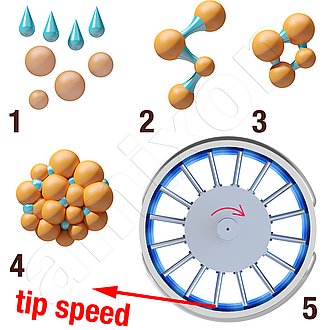Agglomeration
What does agglomeration mean?
In powder processing, agglomeration is defined as a process of accumulating fine material into cohesive units such as pellets or granules. In simple terms, powder agglomeration shifts fine, powdery particles to a coarser size range that facilitates handling and storage.
Basically, agglomeration is a natural accompanying process that takes place with varying effectiveness during the handling or mixing and drying of powders.
While powder agglomeration changes the visual appearance of bulk materials, the product - chemically speaking - remains exactly as it was before agglomeration. The only difference is that agglomerated particles are held together by binding mechanisms, and their bulk density and flowability can change as a result. Depending on the type of agglomeration process, the porosity in the agglomerate can increase or decrease. Agglomerates that are similar in size and have a uniform porosity inside usually have good dissolving and dispersing behaviour when they come into contact with liquids. The process can be either discontinuous or continuous.
How is powder agglomerated?
Choosing a suitable agglomeration process can be a difficult task. The different processes vary in cost. There are bulk materials that agglomerate very readily, others are considered difficult to agglomerate and a liquid binder is often added to them. Some materials should be compacted as densely as possible into flakes, others should be porous, easily soluble and dispersible. The latter then often originate from the fluidised bed agglomerator.
Other agglomeration processes are: Pelletising turntables, pelletising tubes, powder mixers, ring-layer mixing granulators, briquetting presses and roller compactors or tablet presses.
With the twin-shaft mixer type: HM from amixon®, heterogeneous powders can be wetted with liquid components and agglomerated to produce an almost dust-free, easy-flowing instant product. With the ring-layer mixing agglomerator type RMG, uniformly round beads (pellets) can be produced from dusty powders.
Agglomeration can occur spontaneously during mixing. For example, when liquids are added during powder mixing. However, the phenomenon of agglomeration is often undesirable. It causes powders to block and clump. It causes powders to flow poorly. They are then difficult to convey and dose. Sometimes the use of flow aids can help.
Powder agglomeration techniques
There are three main industrial techniques for particle agglomeration: pressure agglomeration, sintering and build-up granulation.
Pressure agglomeration
In pressure agglomeration, powder or other dry particles are mechanically pressed into the desired solid form. The resulting force can vary in intensity: from low-pressure extrusion to high-pressure rolling to punch compaction. Pressure agglomeration is usually a dry process. Moisture or binders are not or hardly required. Common household products made by pressure agglomeration include effervescent or medicinal tablets, charcoal briquettes and cat litter.
Sintering
Sintering, also known as fritting, is a thermal agglomeration process in which atoms diffuse within materials. Powder masses are first shaped so that there is minimal cohesion between the powder particles. In sintering, products are heated without melting them. It is therefore particularly suitable for materials with a very high melting point. Sintering is therefore often used in powder metallurgy and fine ceramics.

Built-up granulation
Built-up pelletising, also called pelletising, is the most versatile method of agglomeration and is typically used in the manufacture of consumer goods. This method involves particularly high-speed rotation to allow powdery particles to combine into larger, denser particles.
As the rotational motion of the mixing chamber pushes the powders to the edges, the particles move along the same path. In the long run, this creates a snowball effect where the particles gradually combine and diffuse to a coarser size range. Build-up pelletisation is usually a wet process where moisture or binders are added.
Granulation, pelletisation, micro-pelletisation and conditioning are examples of common build-up granulation techniques. Each process differs in size, shape, particle size distribution and uniformity of the pellets produced. Flow mixers or ring-layer mixing granulators can be used as wet granulators or pelletisers. If particularly large agglomerates are desired, multi-stage agglomeration can be used. A pelletising plate is then used.
Spray and fluidised bed agglomeration for instant products
Here, the powders are dispersed and dissolved in a liquid in such a way that they can be sprayed through a nozzle. The spraying process takes place above a heated drying or spraying tower. The sprayed droplets sink downwards in the hot, swirling air. Once they reach the bottom, the droplets are dried out. The heated powder particles can optionally agglomerate with other powders in a pneumatic fluidised bed. Agglomerates produced in this way are usually readily soluble when mixed with liquid. The fluidised bed process is used in many fields of the food and pharmaceutical industries. "Instantised" powders are low in dust, flow well and sink well in the liquid phase, as well as being readily dispersible and soluble.
